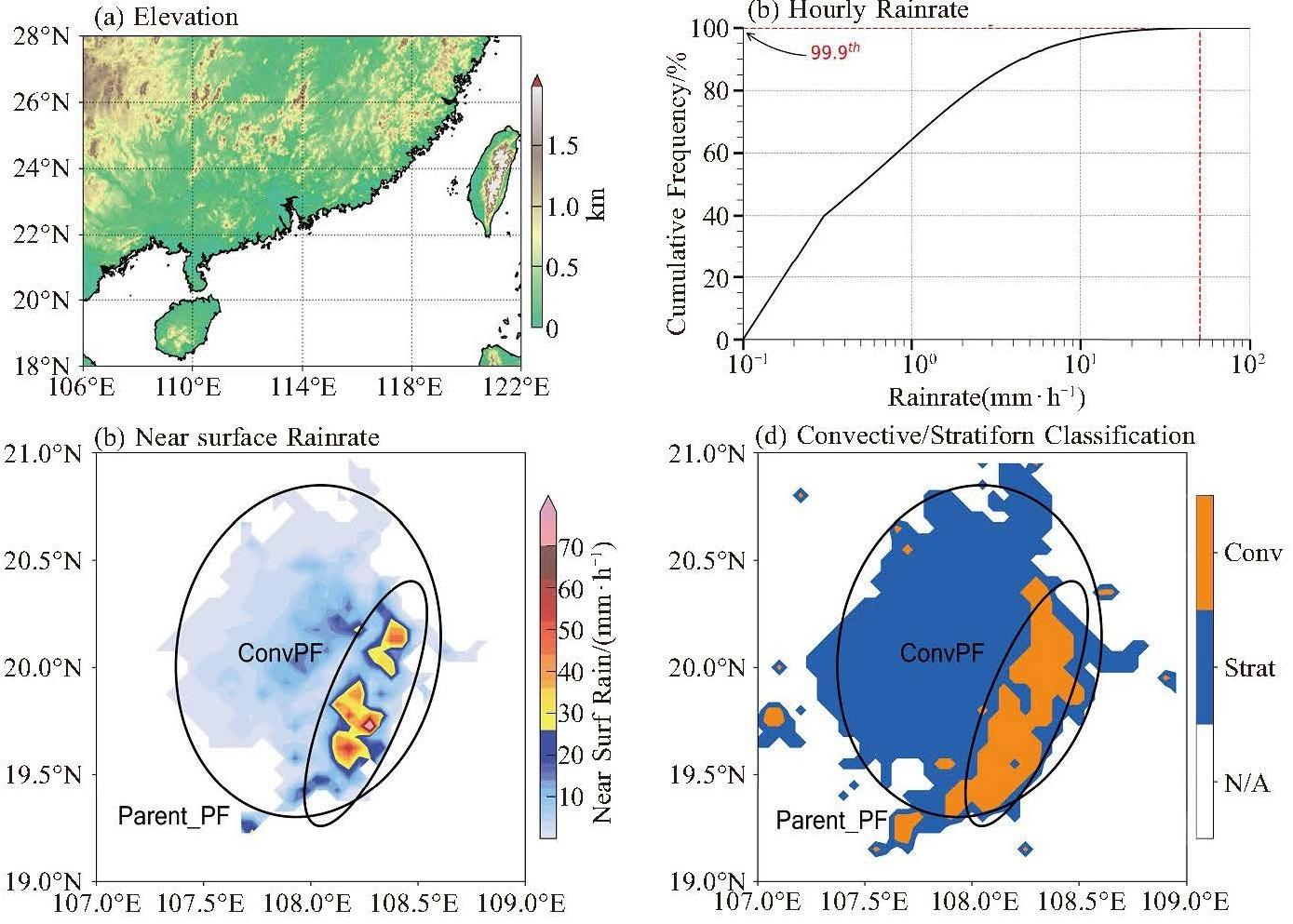Macro and Micro Characteristics of Extreme Precipitation Systems and Non-extreme Precipitation Systems over South China During the Warm Season Based on TRMM Observations from 1998 to 2013
-
摘要: 本研究利用Tropical Rainfall Measuring Mission(TRMM)卫星数据研究了华南地区1998—2013年暖季(4—9月)极端降水系统(Extreme Precipitation Event, 简称EPE)的精细结构和环境特征,并对比分析了非极端降水系统(NonEPE)包括雷暴(Thunderstorm)和未造成极端降水的强对流系统NonEPE_Inten。利用华南地区约1 500个站点的小时降水数据,1981—2013年气候统计的99.9th作为极端小时降水阈值。EPE(NonEPE)定义为降水中心强度达到(未达到)极端小时降水阈值且降水面积至少为100 km2的对流系统。结果表明,华南EPE对流核的水平尺度达到了中β尺度(45~50 km),与雷暴尺度相当;大部分EPE发生在组织性强的中尺度对流系统(>100 km)内,NonEPE多数发生在尺度相对较小的对流系统(< 100 km)中。卫星微波观测表明EPE含有丰富的冰相粒子,冰相过程显著。EPE与强对流的垂直结构具有显著差异,它们的雷达反射率因子在融化层以下分别增长了6~7 dBZ和2~3 dBZ,表明EPE暖雨(碰并)过程更活跃,其雨滴在暖云中高效增长。EPE的环境特征表现为整层大气相对湿度高,700~925 hPa风切变强,暖云厚度更深厚,但对流有效位能(CAPE)较弱,低层气温较低。Abstract: This study investigates the precipitation structures and environmental conditions of Extreme Precipitation Events (EPEs) over South China during the warm season (April-September, 1998-2013) using TRMM satellite data. The structure and environmental characteristics of the Non-Extreme Precipitation Events (NonEPEs), including thunderstorm, and the convective NonEPEs (NonEPE_Inten), which lacks extreme precipitation, are compared and analyzed. The hourly extreme precipitation threshold is defined using the 99.9th percentile of hourly precipitation data of about 1 500 stations in South China during 1981-2013. EPE (NonEPE) refers a convective system in which the intensity of the precipitation center meets (does not meet) the extreme hourly precipitation threshold, and the precipitation area is at least 100 km2. Results indicate that the horizontal scale of EPE over South China exhibits meso-β scale (45-50 km), which is the scale of thunderstorms. Most EPEs occur in organized mesoscale convective systems (horizontal scale > 100 km), while NonEPEs primarily occur in relatively small-scale convective systems (horizontal scale < 100 km). Satellite microwave observations indicate that EPEs contain abundant ice particles. The vertical structure of EPE is significantly different from that of strong convections. The radar reflectivity of EPE (non-EPE) increases by 6-7 dBZ (2-3 dBZ) below the melt layer, indicating EPE has a more active warm rain or collision-coalescence process with higher raindrop growth efficiency. In terms of environmental conditions, EPE show higher relative humidity, stronger 700-925 hPa wind shear, thicker warm cloud depth, weaker convective effective potential energy (CAPE), and lower low-level temperature.
-
图 4 同图 3,ConvPF水平尺度(a)、ConvPF面积(b)、Parent_PF水平尺度水平结构(c)和Parent_PF层状性降水面积比例(d)
表 1 不同类型的对流系统的定义及样本数量,时间范围为1998—2013年4—9月(包含台风降水有关的对流系统),空间范围为研究区域的陆地
类别 对流系统定义 样本数量 EPE Max nearsurf rainrate ≥50.4 mm·h-1 4 661 NonEPE Max nearsurf rainrate: 5~50 mm·h-1 36 088 NonEPE_Inten NonEPE & echotop30 ≥8 km 2 490 Thunderstorm Flashrate ≥1 min-1 5 546 -
[1] LUO Y, WANG H, ZHANG R, et al. Comparison of rainfall characteristics and convective properties of monsoon precipitation systems over south China and the Yangtze and Huai river basin[J]. J Climate, 2013, 26(1): 110-132. [2] WANG H, LUO Y, JOU B J. Initiation, maintenance, and properties of convection in an extreme rainfall event during SCMREX: observational analysis[J]. J Geophys Res Atmos, 2014, 119(23): 13 206-13 232. [3] DU Y, CHEN G. Climatology of low-level jets and their impact on rainfall over southern China during the early-summer rainy season[J]. J Climate, 2019, 32(24): 8 813-8 833. [4] DU Y, CHEN G. Heavy rainfall associated with double low-level jets over southern China. Part Ⅰ: Ensemble-based analysis[J]. Mon Wea Rev, 2018, 146(11): 3 827-3 844. [5] DU Y, CHEN G. Heavy rainfall associated with double low-level jets over southern China. Part Ⅱ: Convection initiation[J]. Mon Wea Rev, 2019, 147(2): 543-565. [6] YING M, YANG Y, CHEN B, et al. Climatic variation of tropical cyclones affecting China during the past 50 years[J]. Sci China Earth Sci, 2011, 54(8): 1 226-1 237. [7] LIU H, HUANG X, FEI J, et al. Characteristics and preliminary causes of extremely persistent heavy rainfall generated by landfalling tropical cyclones over China[J]. EARTH SPACE SCI, 2022, 9(4): e2022EA002238. [8] 孙建华, 赵思雄. 华南"94·6"特大暴雨的中尺度对流系统及其环境场研究Ⅱ. 物理过程、环境场以及地形对中尺度对流系统的作用[J]. 大气科学, 2002, 26(5): 633-646. [9] WU M, LUO Y, CHEN F, et al. Observed link of extreme hourly precipitation changes to urbanization over coastal south China[J]. J Appl Meteor Climatol, 2019, 58(8): 1 799-1 819. [10] 黄土松, 李真光, 包澄澜, 等. 华南前汛期暴雨[M]. 广州: 广东科技出版社, 1986. [11] 陈红, 赵思雄. 海峡两岸及邻近地区暴雨试验(HUAMEX) 期间暴雨过程及环流特征研究[J]. 大气科学, 2004, 28(1): 32-47. [12] ZHANG R, NI Y, LIU L, et al. South China heavy rainfall experiments (SCHeREX)[J]. J Meteor Soc Japan, 2011, 89A: 153-166. [13] LUO Y, ZHANG R, WAN Q, et al. The southern China monsoon rainfall experiment (SCMREX)[J]. Bull Amer Meteor Soc, 2017, 98(5): 999-1 013. [14] 何立富, 陈涛, 孔期. 华南暖区暴雨研究进展[J]. 应用气象学报, 2016, 27(5): 559-569. [15] REN F, GLEASON B, EASTERLING D. Typhoon impacts on China's precipitation during 1957-1996[J]. AdvAtmos Sci, 2002, 19(5): 943-952. [16] HSU P C, LEE J Y, HA K J. Influence of boreal summer intraseasonal oscillation on rainfall extremes in southern China[J]. Int J Climatol, 2016, 36(3): 1 403-1 412. [17] LI H, WAN Q, PENG D, et al. Multiscale analysis of a record-breaking heavy rainfall event in Guangdong, China[J]. Atmos Res, 2020, 232: 104703. [18] HOUZE J R A, RASMUSSEN K L, ZULUAGA M D, et al. The variable nature of convection in the tropics and subtropics: a legacy of 16 years of the Tropical Rainfall Measuring Mission satellite[J]. Rev Geophys, 2015, 53(3): 994-1 021. [19] XU W, ZIPSER E J. Properties of deep convection in tropical continental, monsoon, and oceanic rainfall regimes[J]. Geophys Res Lett, 2012, 39(7): L07802. [20] ZIPSER E J, CECIL D J, LIU C, et al. Where are the most intense thunderstorms on earth?[J]. Bull Amer Meteor Soc, 2006, 87(8): 1 057-1 072. [21] DEIERLING W, PETERSEN W A. Total lightning activity as an indicator of updraft characteristics[J]. J Geophys Res Atmos, 2008, 113 (D16): D16210. [22] ZIPSER E J. Deep cumulonimbus cloud systems in the tropics with and without lightning[J]. Mon Wea Rev, 1994, 122(8): 1 837-1 851. [23] HAMADA A, MURAYAMA Y, TAKAYABU Y N. Regional characteristics of extreme rainfall extracted from TRMM PR measurements[J]. J Climate, 2014, 27(21): 8 151-8 169. [24] HAMADAA, TAKAYABU Y N, LIU C, et al. Weak linkage between the heaviest rainfall and tallest storms[J]. Nat Commun, 2015, 6(1): 6 213. [25] GAO Y Y, LI M X, LUO Y L, et al. How do the convective and microphysical characteristics of extreme precipitation over the Pearl River Delta at monsoon coast vary with increasing rainfall extremity?[J]. Geophys Res Lett, 2023, 50(19): e2023GL104625. [26] SOHN B J, RYU G, SONG H, et al. Characteristic features of warm-type rain producing heavy rainfall over the Korean Peninsula inferred from TRMM measurements[J]. Mon Wea Rev, 2013, 141(11): 3 873-3 888. [27] XU W, CHEN H, WEI H, et al. Extreme precipitation produced by relatively weak convective systems in the tropics and subtropics[J]. Geophys Res Lett, 2022, 49(7): e2022GL098048. [28] LIU C, ZIPSER E J. ''Warm Rain'' in the tropics: Seasonal and regional distributions based on 9 yr of TRMM data[J]. J Climate, 2009, 22 (3): 767-779. [29] LIU C, ZIPSER E J. Why does radar reflectivity tend to increase downward toward the ocean surface, but decrease downward toward the land surface?[J]. J Geophys Res Atmos, 2013, 118(1): 135-148. [30] YU S, LUO Y, WU C, et al. Convective and microphysical characteristics of extreme precipitation revealed by multisource observations over the Pearl River Delta at monsoon coast[J]. Geophys Res Lett, 2022, 49(2): e2021GL097043. [31] 杨忠林, 赵坤, 徐坤, 等. 江淮梅雨期极端对流微物理特征的双偏振雷达观测研究[J]. 气象学报, 2019, 77(1): 58-72. [32] YU S, LUO Y, WU C, et al. Subseasonal variations of convective and microphysical characteristics of extreme precipitation over the Pearl River Delta at monsoon coast[J]. J Geophys Res Atmos, 2023, 128(3): e2022JD037804. [33] KUMMEROW C, BARNES W, KOZU T, et al. The Tropical Rainfall Measuring Mission (TRMM) sensor package[J]. J Atmos Oceanic Technol, 1998, 15(3): 809-817. [34] KUMMEROW C, SIMPSON J, THIELE O, et al. The status of the Tropical Rainfall Measuring Mission (TRMM) after two years in orbit [J]. J Appl Meteor Climatol, 2000, 39(12): 1 965-1 982. [35] CHRISTIAN H J, BLAKESLEE R J, GOODMAN S J, Lightning Imaging Sensor (LIS) for the Earth Observing System[R]. Huntsville AL: NASA/Marshall Space Flight Center, 1992. [36] CHRISTIAN H J, BLAKESLEE R J, GOODMAN S J, et al, Algorithm Theoretical Basis Document (ATBD) for the Lightning Imaging Sensor (LIS)[R]. Huntsville AL: NASA/Marshall Space Flight Center, 2000. [37] LIU C, ZIPSER E J, CECIL D J, et al. A cloud and precipitation feature database from nine years of TRMM observations[J]. J Appl Meteor Climatol, 2008, 47(10): 2 712-2 728. [38] LIU C, ZIPSER E J. Global distribution of convection penetrating the tropical tropopause[J]. J Geophys Res Atmos, 2005, 110(D23); D23104. [39] ZIPSER E J. Deep cumulonimbus cloud systems in the tropics with and without lightning[J]. Mon Wea Rev, 1994, 122(8): 1 837-1 851. [40] DEMOTT C A, RUTLEDGE S A. The vertical structure of TOGA COARE convection. Part Ⅰ: radar echo distributions[J]. J Atmos Sci, 1998, 55(17): 2 730-2 747. [41] CECIL D J, GOODMAN S J, BOCCIPPIO D J, et al. Three years of TRMM precipitation features. Part Ⅰ: radar, radiometric, and lightning characteristics[J]. Mon Wea Rev, 2005, 133(3): 543-566. [42] CECIL D J, BLANKENSHIP C B. Toward a global climatology of severe hailstorms as estimated by satellite passive microwave imagers [J]. J Climate, 2012, 25(2): 687-703. [43] 张强, 赵煜飞, 范邵华. 中国国家级气象台站小时降水数据集研制[J]. 暴雨灾害, 2016, 35(2): 182-186. [44] 任芝花, 赵平, 张强, 等. 适用于全国自动站小时降水资料的质量控制方法[J]. 气象, 2010, 36(7): 123-132. [45] HERSBACH H, BELL B, BERRISFORD P, et al. The ERA5 global reanalysis[J]. Quart J Roy Meteorol Soc, 2020, 146(730): 1 999-2 049. [46] LUO Y, WU M, REN F, et al. Synoptic situations of extreme hourly precipitation over China[J]. J Climate, 2016, 29(24): 8 703-8 719. [47] HOUZE R A. 100 years of research on mesoscale convective systems[J]. Meteor Monogr, 2018, 59(1): 17.1-17.54. [48] YUTER S E, HOUZE R A. Three-dimensional kinematic and microphysical evolution of florida cumulonimbus. Part Ⅱ: frequency distributions of vertical velocity, reflectivity, and differential Reflectivity[J]. Mon Wea Rev, 1995, 123(7): 1 941-1 963. [49] CRAVEN J P, BROOKS H E. Baseline climatology of sounding derived parameters associated with deep, moist convection[J]. Nat Wea Dig, 2004, 28(1): 13-24. -






 下载:
下载:








 粤公网安备 4401069904700003号
粤公网安备 4401069904700003号